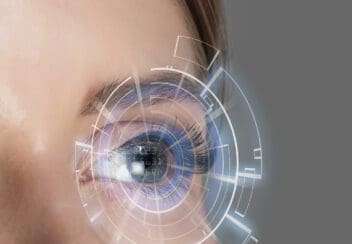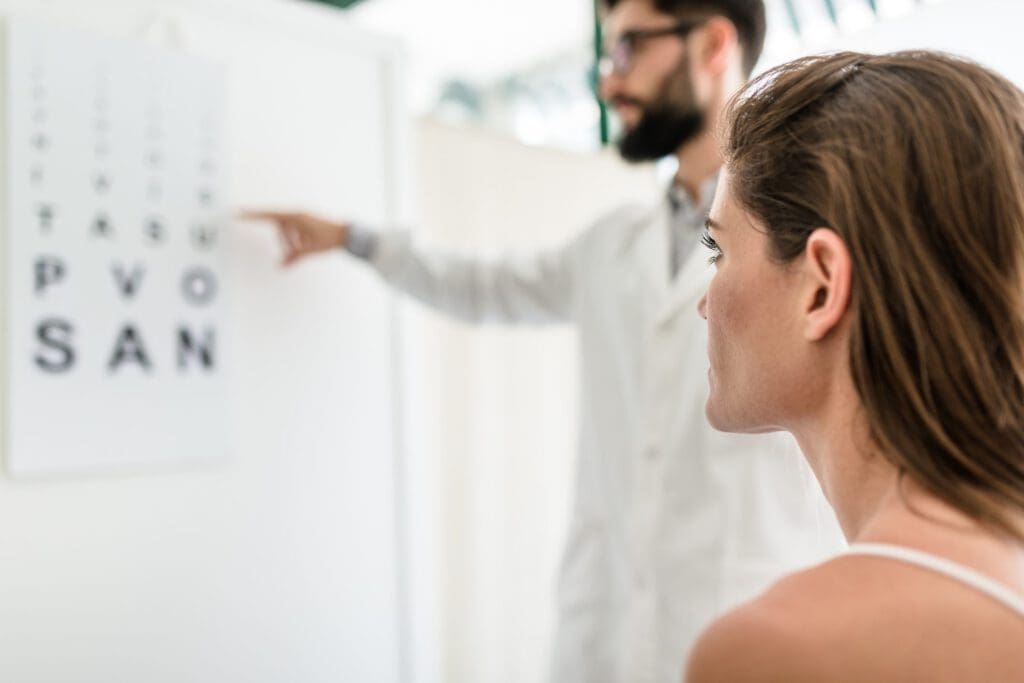
Medically Reviewed by Tom Tooma, M.D., Founder/Medical Director NVISION Surgeon
Better Than 20/20 Vision With LASIK: Is It Possible?
Home / How to Improve Your Eyesight Naturally /
Last Updated:

Medically Reviewed by Tom Tooma, M.D., Founder/Medical Director NVISION Surgeon
LASIK Eye Surgery Outcomes: Can You Get Better than 20/20?
Most people around the world have 20/20 visual acuity. This is the normal and health state of being for eyesight in humans, and it is against this barometer that we measure how much vision needs to be corrected.
With increasing advances in technology and precision surgeries, if you have a refractive error like farsightedness or shortsightedness you can bring your vision to 20/20 – or even better – with LASIK surgery.
Historical data from years of LASIK research shows that more than 90 percent of people who undergo LASIK obtain 20/20 vision or better. Yes, it’s possible to get vision clearer than 20/20 after surgery.
Better than normal vision means that, what most people see well from 19 feet or 18 feet, you can comfortably recognize from 20 feet. While you could use the best eyesight possible, anything better than 20/20 isn’t necessarily the best treatment outcome.
Because of overcorrection, some people can have one part of their vision improved markedly and yet have another area become compromised. That is why you should discuss your treatment goals and expectations with your ophthalmologist beforehand if you’re considering LASIK surgery.
Table of Contents
What Is 20/20 Vision?

The most common measurement of vision and associated problems involves measuring 20/20 vision. The number simply stands for the ability to see objects at a range of 20 feet; if you can see all objects clearly in your path within 20 feet, you have perfect vision. If you cannot see things far away, you are nearsighted (myopia), and being unable to see objects up close is farsightedness (hyperopia).
There are other important measures of visual acuity.
You deserve clear vision. We can help.
With 135+ locations and over 2.5 million procedures performed, our board-certified eye surgeons deliver results you can trust.
Your journey to better vision starts here.
- Peripheral awareness or side vision
- Eye coordination
- Depth perception
- Ability to focus
- Color vision
These are measurements of different, but equally important, aspects of your overall ability to see the world around you while 20/20 vision measures specific issues with the cornea and the refraction of light to the retina to create a clear visual picture. If you have 20/30 vision, your vision is poorer than average because you need to be 20 feet from objects that people with average vision can see clearly at 30 feet. In most cities and states, you can get an unrestricted driver’s license if your uncorrected vision is 20/40 or better. People who wear corrective items like glasses or contacts and who still have 20/200 vision with these corrections are considered legally blind because they are unable to attain clear vision. Many children begin to lose their visual acuity around 8 or 9 years old.
Since 20/20 means measuring your ability so see clearly at a distance of 20 feet, is it possible to have better than 20/20 vision? In fact, 20/20 vision is not considered perfect; it’s just one measurement of visual acuity. You can have 20/20 vision but still suffer from other vision problems.

How Is Normal Vision Measured?
Although the term 20/20 is commonly used, it is a measurement predominantly used in the United States because the country is on the English system, measuring in inches, feet, and yards. In the United Kingdom, for example, normal vision is called 6/6 because visual acuity is measured within 6 meters.
Most people who have had an eye exam are familiar with the chart using letters, starting with a large E at the top, to measure visual acuity. This is called the Snellen Chart, named after Dutch eye doctor Herman Snellen who invented it in the 1860s. He also created a second chart, called the Tumbling E chart, which uses the large E in different orientations and sizes, as a method to help those who could not read. The doctor asks their patient to point their fingers in the direction that the “fingers” of the E are pointing on different lines. Using a standardized chart like the Snellen Charts allows people to go to any optometrist or oculist for a prescription and then go to any glasses maker for a set of glasses to correct their vision.
Standardization has helped optometrists, ophthalmologists, and other eye doctors understand different approaches to their patients’ vision problems and find ways to correct vision beyond prescribing glasses to adjust refraction problems. There are also many more steps in a common eye exam now than looking at a Snellen Chart.
- Discussing your history of vision problems
- Evaluating other aspects of your vision, such as eye pressure, muscle movements, and color vision
- Measuring how your pupils respond to light
- Keratometry to measure the curvature of the cornea
- Using a phoropter to determine if new refraction (a series of lenses) helps, hurts, or does not do anything
These tests and others will determine your overall eye health. If you have seen an optometrist to get prescriptions for corrective wear due to a refraction error, you may ask about LASIK to correct your vision. An in-depth eye exam will help your eye doctor understand if you are a good candidate for LASIK, if you would benefit more from a different refraction procedure, or if an underlying eye problem would prevent that surgery from benefiting your vision.
Factors That Influence the Results of LASIK
One of the most important questions to ask your eye surgeon is whether LASIK is safe and good for you. The treatment outcome and your satisfaction level will depend on several factors, including:
- Level of vision correction required: LASIK works best within certain ranges of refractive errors. The more severe your vision problem is, the harder it is to get good results with LASIK.
- Pre-existing medical conditions: Immunodeficiency diseases like AIDS may impact recovery after LASIK surgery. Conditions that affect your vision, such as diabetes, can also compromise the effectiveness of treatment.
- Changes in your vision: Your ophthalmologist determines how much vision correction to apply based on your vision stability over the past 12 months. If you’ve had recent changes in your visual health or prescription glasses, you may not be a good LASIK candidate.
- Your age: LASIK is generally not considered safe or effective for patients under 21 years because their eyes are still developing.
- Medication: Tell your surgeon before LASIK if you’re taking any over-the-counter or prescription medication. Many drugs can influence treatment outcomes and the way laser surgery affects your cornea.
- Preexisting eye disorders: Dry eye, glaucoma and corneal problems can impact LASIK surgery outcomes.
You deserve clear vision. We can help.
With 135+ locations and over 2.5 million procedures performed, our board-certified eye surgeons deliver results you can trust.
Your journey to better vision starts here.
Why You Do Not Want Better Than 20/20 Vision?
Your LASIK treatment has worked if it gives you vision 20/20 or anything close to normal eyesight without adverse, irreversible complications. Vision of 20/15 is much better and clearer if it’s natural.
However, correcting your eyesight to better than 20/20 may cause undesired vision defects. These may include:
- Hazy vision
- Eyestrain
- Headache
Also, you don’t want your vision overcorrected, which is a possibility with LASIK. You may need to wear glasses or another eye surgery to see clearly if this side-effect occurs after surgery.
When your vision is overcorrected for nearsightedness, you’ll see objects that are far clearly. But the overcorrection will result in farsightedness.
Conversely, overcorrecting farsightedness causes nearsightedness.
How LASIK Can Help You Achieve 20/20 Vision
LASIK is a type of laser surgery that corrects refractive vision errors when the eye is unable to bend light properly. This defect may cause you to experience one of these three vision problems:
- Farsightedness
- Nearsightedness
- Astigmatism (when your cornea or lens has an abnormal shape)
During the LASIK procedure, your eye surgeon will use a laser to reshape your cornea. This procedure can bring your vision close to 20/20 by improving the way your eye focuses light on the retina.
As with any other treatment, make sure to discuss your expectations and goals with your ophthalmologist. It’s best to be cautiously optimistic about results and accept that LASIK may produce less-than-perfect vision.
Other concerns you may discuss with your surgeon before surgery include:
- How will surgery impact your everyday life at work, home or school, including the ability to participate in social activities, sports, or recreation?
- What are your options if LASIK doesn’t work?
- What vision improvements can you expect in the first few months after surgery?
- What are the common LASIK side-effects?
Other Conditions That May Impact Your Vision
If you have the following eye conditions, you shouldn’t have LASIK. Other treatments, including surgery, may be more appropriate.
- Severe dry eye
- Corneal erosion (when your cornea’s outer layer is damaged)
- Severe glaucoma (when your eye’s optic nerve is damaged)
- Your cornea is too thin for LASIK surgery
- Signs of keratoconus (a vision-threatening defect where your cornea thins and slowly protrudes outward into a cone shape)
You deserve clear vision. We can help.
With 135+ locations and over 2.5 million procedures performed, our board-certified eye surgeons deliver results you can trust.
Your journey to better vision starts here.
References
- What Does 20/20 Vision Mean? (November 30, 2016). American Academy of Ophthalmology (AAO).
- Visual Acuity: What Is 20/20 Vision? American Optometric Association (AOA).
- Visual Acuity FAQs. American Optometric Association (AOA).
- All About the Eye Chart. (November 30, 2016). American Academy of Ophthalmology (AAO).
- Comprehensive Eye and Vision Examination. American Optometric Association (AOA).
- Laser Surgery Can Improve Vision Problems. University of Rochester Medical Center.
- Manage Overcorrected LASIK With CLAPIKS. (April 2001). Healio: Primary Care Optometry News.
- What is the LASIK Success Rate? (October 2021). American Refractive Surgery Council.
- Topography- Assisted LASIK Treatment for Nearsightedness (Myopia) with Astigmatism using the Nidek EC-5000 Excimer Laser System. (September 2013). Nidek EC-5000 Excimer Laser System Patient Information Booklet.
- 20/15 vision: Better or worse than 20/20? (October 2021). All About Vision.
- LASIK — Laser Eye Surgery. (October 2021). American Academy of Ophthalmology.

Dr. Tooma, the founder of NVISION® Eye Centers, has performed well over 130,000 LASIK surgeries, making him the most experienced LASIK surgeon in the Western United States.
This content is for informational purposes only. It may have been reviewed by a licensed physician, but is not intended to serve as a substitute for professional medical advice. Always consult your healthcare provider with any health concerns. For more, read our Privacy Policy and Editorial Policy.
